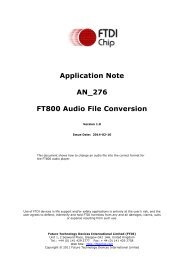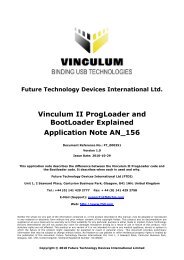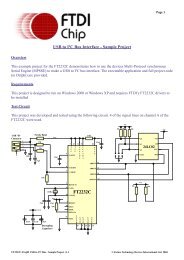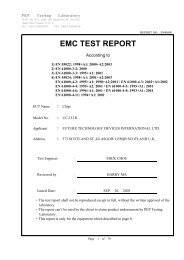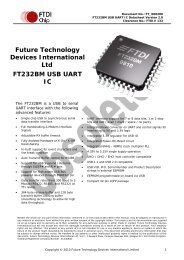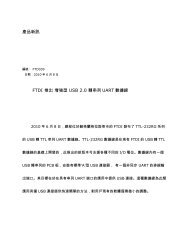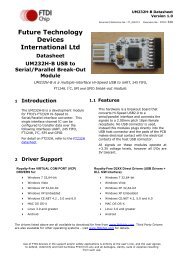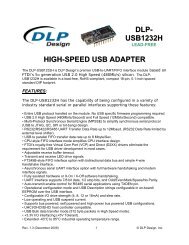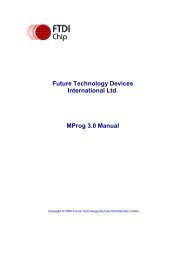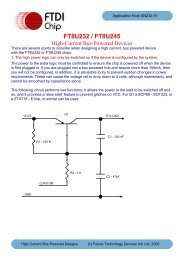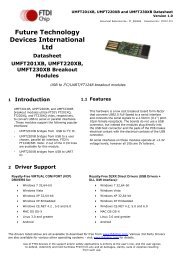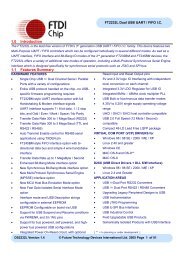You also want an ePaper? Increase the reach of your titles
YUMPU automatically turns print PDFs into web optimized ePapers that Google loves.
2. Features and Enhancements<br />
2.1 Key Features<br />
This section summarises the key features and enhancements of the FT232RL IC device which is used on the<br />
<strong>EVAL232R</strong> Module. For further details, consult the FT232R datasheet, which is available from the <strong>FTDI</strong> website.<br />
Integrated Clock Circuit - Previous generations of <strong>FTDI</strong>’s USB UART devices required an external crystal or ceramic<br />
resonator. The clock circuit has now been integrated onto the device meaning that no crystal or ceramic resonator is<br />
required. However, if required, an external 12MHz crystal can be used as the clock source.<br />
Integrated EEPROM - Previous generations of <strong>FTDI</strong>’s USB UART devices required an external EEPROM if the<br />
device were to use USB Vendor ID (VID), Product ID (PID), serial number and product description strings other than<br />
the default values in the device itself. This external EEPROM has now been integrated onto the FT232R chip meaning<br />
that all designs have the option to change the product description strings. A user area of the internal EEPROM is<br />
available for storing additional data. The internal EEPROM is programmable in circuit, over USB without any additional<br />
voltage requirement.<br />
Preprogrammed EEPROM - The FT232R is supplied with its internal EEPROM preprogrammed with a serial number<br />
which is unique to each individual device. This, in most cases, will remove the need to program the device EEPROM.<br />
Integrated USB Resistors - Previous generations of <strong>FTDI</strong>’s USB UART devices required two external series resistors<br />
on the USBDP and USBDM lines, and a 1.5 kΩ pull up resistor on USBDP. These three resistors have now been<br />
integrated onto the device.<br />
Integrated AVCC Filtering - Previous generations of <strong>FTDI</strong>’s USB UART devices had a separate AVCC pin - the<br />
supply to the internal PLL. This pin required an external R-C filter. The separate AVCC pin is now connected internally<br />
to VCC, and the filter has now been integrated onto the chip.<br />
Less External Components - Integration of the crystal, EEPROM, USB resistors, and AVCC filter will substantially<br />
reduce the bill of materials cost for USB interface designs using the FT232R compared to its FT232BM predecessor.<br />
Configurable CBUS I/O Pin Options - There are now 5 configurable Control Bus (CBUS) lines. Options are TXDEN<br />
- transmit enable for RS485 designs, PWREN# - Power control for high power, bus powered designs, TXLED# - for<br />
pulsing an LED upon transmission of data, RXLED# - for pulsing an LED upon receiving data, TX&RXLED# - which<br />
will pulse an LED upon transmission OR reception of data, SLEEP# - indicates that the device going into USB<br />
suspend mode, CLK48 / CLK24 / CLK12 / CLK6 - 48MHz, 24MHz,12MHz, and 6MHz clock output signal options.<br />
There is also the option to bring out bit bang mode read and write strobes (see below). The CBUS lines can be<br />
configured with any one of these output options by setting bits in the internal EEPROM. The device is supplied with<br />
the most commonly used pin definitions preprogrammed - see Section 8 for details.<br />
Enhanced Asynchronous Bit Bang Mode with RD# and WR# Strobes - The FT232R supports <strong>FTDI</strong>’s BM chip<br />
bit bang mode. In bit bang mode, the eight UART lines can be switched from the regular interface mode to an 8-bit<br />
general purpose I/O port. Data packets can be sent to the device and they will be sequentially sent to the interface<br />
at a rate controlled by an internal timer (equivalent to the baud rate prescaler). With the FT232R device this mode<br />
has been enhanced so that the internal RD# and WR# strobes are now brought out of the device which can be used<br />
to allow external logic to be clocked by accesses to the bit bang I/O bus. This option will be described more fully in a<br />
separate application note.<br />
Synchronous Bit Bang Mode - Synchronous bit bang mode differs from asynchronous bit bang mode in that the<br />
interface pins are only read when the device is written to. Thus making it easier for the controlling program to measure<br />
the response to an output stimulus as the data returned is synchronous to the output data. The feature was previously<br />
seen in <strong>FTDI</strong>’s FT2232C device. This option will be described more fully in a separate application note.<br />
CBUS Bit Bang Mode - This mode allows four of the CBUS pins to be individually configured as GPIO pins, similar<br />
to Asynchronous bit bang mode. It is possible to use this mode while the UART interface is being used, thus providing<br />
up to four general purpose I/O pins which are available during normal operation. An application note describing this<br />
feature is available separately from the <strong>FTDI</strong> website.<br />
<strong>EVAL232R</strong> FT232RL USB to RS232 Evaluation Module <strong>Datasheet</strong> Version 0.90 © Future Technology Devices International Ltd. 2005<br />
Page 3



